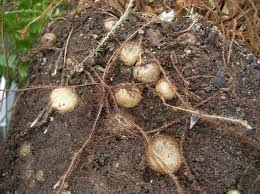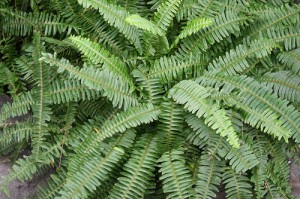Foraging before there was botany had to be a lot easier than after botany. Someone showed you what was edible and that was that. Of course somewhere back along the line a few thousands years there was some experimentation but for most of human history it foraging was a case of eat like mom ate, or the tribe.
I grew up in an area where fiddlehead ferns were a Rite of Spring, if not one of the endearing hold overs from the past. When I moved to Florida I didn’t leave that behind but there are less fiddleheads here and harder to find. Also, where it is green most of the year spring greenery just isn’t as significant as it is in the gray north.
The other displeasure was personal: My yard in Florida was filled with a non-edible fern that took over everywhere there was some shade. And as much as I could tell it never produced a single fiddlehead either. I knew the fern well because I was always digging it and its tubers up, moving them or tossing a few. In eight years it has survived one hard freeze and cover virtually half my open space, the reducing mowing. The fern was also the only fern on the exotic pest list of the state of Florida. That alone should have been a clue.
My fern is Nephrolepis cordifolia, a non-native “Boston” fern that showed up in Florida from somewhere in the 1930s. It caused quite a stink in that it was, and is, often sold in place of the native fern Nephrolepis exaltata, the Sword Fern. But of the five Nephrolepis in Florida only the cordilfolia had tubers. That should have been the second clue.
I recently bought a Florida fern book because I simply wanted to know more about them. There’s around 160 different ferns in Florida and they ain’t easy to tell apart. Determined to expand the choice of fiddleheads, I was looking for edible ferns on the internet when I hit on one page that said the tubers of the N. cordifolia were edible.
Edible? None of my 40 books had said that but I did find a botanical study in Nepal on the nutritional elements of the same fern. It was also written up in a book but that particular page is not available on the internet. So I am left with the phrase the tubers of the N. cordifloia “are eaten fresh and roasted.” And in time I learn so they are, and now that lawn of non-edible ferns has purpose again.




Hello Deane,
Thanks for the Sword Fern write up. Had a follow up question — are you aware if other Fern Tubers are also edible? I was dividing a Foxtail Fern and found very similar looking tubers.
Fern tubers are a luck of the draw. Some — very few — have edible roots and even fewer of them save enough starch to make the root worth the wile.
Hi from Mexico
Very interestig this information over Nephrolepis. The two species are weed in many tropical spaces in Mexico, where the people are very poor. But I have understand that many species of ferns are toxic; the fenolic sustances are cancerigenous. The Pteridium weed fiddleheads are a good exaple. What do you Thing?